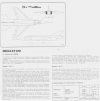groundhogday666
Banned
If a Breguet fighter is in the mix, and personally I think it should be then the Br120 is the one to go for. The Sirocco is too old a design and far too small to meet the British requirement and while the Br121 that was a basis for the Jaguar is much newer it also is way too small. The Br120 is twin Spey powered and weighs 35,000lbs and is 19m long (same and a Phantom) so is as big as the Clems can handle but seems to have a lot of engine for the era, I think it could get away with 25-30,000lbs of thrust.
Fair enough. The DAFNE indeed, is a 1964 design - larger than the Sirocco and much like a Phantom except more modern.
The RN- FAA OR from the early 60's (OR346 ?) were very complicated and heavy things, with lift jets, VG wings, long range and endurance, big radars, missiles, and loitering times... an in-between F-4K and F-111B / F-14, somewhat..
Well, DAFNE was very much a French counterpart. Breguet 1200 then. See attached an excerpt from a very old book.
